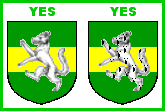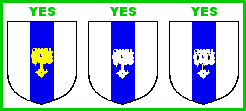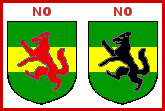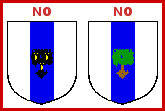1. Armorial Simplicity. - All armory must be simple in design.
a. Tincture and Charge Limit - Armory must use a limited number of tinctures and types of charges.
As the number of tinctures involved in a device increases, the number of types of charge should decrease. As the number of types increases, the number of tinctures should decrease. In no case should the number of different tinctures or types of charges be so great as to eliminate the visual impact of any single design element. As a rule of thumb, the total of the number of tinctures plus the number of types of charges in a design should not exceed eight. As another guideline, three or more types of charges should not be used in the same group.
b. Armorial Balance - Armory must arrange all elements coherently in a balanced design.
Period armory usually places the primary elements of the design in a static arrangement, such as a single charge in the center of the field or three identical charges on an escutcheon. More complex designs frequently include a central focal point around which other charges are placed, like a chevron between three charges, but the design remains static and balanced. Designs that are unbalanced, or that create an impression of motion, are not compatible with period style.
c. Armorial Depth - Armory may not employ depth of field as a design element.
i. Perspective - Charges may only be drawn in perspective if they were so depicted in period armory.
A pair of dice may be drawn in perspective since they were routinely drawn that way in period armory to show the pips. A bear, dolphin, or castle should not be drawn in three dimensions, but should appear only in its standard, flat heraldic form.
ii. Layer Limit - Designs may not be excessively layered.
All charges should be placed either directly on the field or entirely on other charges that lie on the field.
2. Armorial Contrast. - All armory must have sufficient contrast to allow each element of the design to be clearly identifiable at a distance.
Each tincture used in Society armory may be depicted in a variety of shades. Therefore, contrast is not determined by the lightness or darkness of the tinctures on the submitted emblazon, but by the traditional heraldic categorization of tinctures as colors and metals. The colors are azure, gules, purpure, sable, and vert (blue, red, purple, black, and green). Ermined furs or field treatments on a background of one of these tinctures are treated as colors for contrast in the Society.







The metals are argent and Or (white or silver, and yellow or gold). Ermined furs or field treatments on a background of one of those tinctures are treated as metals for contrast in the Society.




Furs equally divided of light and dark pieces, such as vair, are classed with other evenly divided elements, such as paly, per bend, or lozengy.

a. Contrasting Tinctures - Good contrast exists between:
i. A metal and a color;
ii. An element equally divided of a color and a metal, and any other element as long as identifiability is maintained;
iii. A color and a charge, blazoned as proper, that is predominantly light;
iv. A metal and a charge, blazoned as proper, that is predominantly dark.
b. Contrast Requirements -
i. The field must have good contrast with every charge placed directly on it and with charges placed overall.
For example, a pale vair between two owls Or might be placed on a field gules, but not a field ermine because the owls would not have good contrast. Similarly, a field vert with a fess Or contrasts with a wolf rampant overall that is argent or ermine, but not a wolf that is gules or sable.


ii. A charge must have good contrast with any charge placed wholly on it.
For example, a tree placed on a pale azure could be Or, argent, or ermine, but could not be pean or proper.

iii. Elements evenly divided into two parts, per saltire, or quarterly may use any two tinctures or furs.
For example, a field quarterly could be composed of azure and gules, argent and Or, Or and ermine, or vert and vairy gules and argent.



iv. Elements evenly divided into multiple parts of two different tinctures must have good contrast between their parts.
For example, checky argent and gules is acceptable, but checky azure and gules is not.

v. Elements evenly divided in three tinctures must have good contrast between two of their parts.
3. Armorial Identifiability. - Elements must be used in a design so as to preserve their individual identifiability.
Identifiable elements may be rendered unidentifiable by significant reduction in size, marginal contrast, excessive counterchanging, voiding, or fimbriation, or by being obscured by other elements of the design. For instance, a complex line of partition could be difficult to recognize between two parts of the field that do not have good contrast if most of the line is also covered by charges. A complex divided field could obscure the identity of charges counterchanged. Voiding and fimbriation may only be used with simple geometric charges placed in the center of the design.
4. Obtrusive Modernity. - Armory may not use obtrusively modern designs.
"Modern" is defined as anything outside the period of the Society.
a. Pictorial Design - Overly pictorial designs may not be registered.
Design elements should not be combined to create a picture of a scene or landscape. For example, combining a field divided per fess wavy azure and Or with a sun and three triangles Or, as well as a camel and two palm trees proper to depict the Nile Valley would not be acceptable.
b. Modern Insignia - Overt allusions to modern insignia, trademarks, or common designs may not be registered.
Such references, including parodies, may be considered obtrusive. Examples include using a bend within a bordure gules to parody the international "No Entry" sign, variations on the geometric Peace sign, and so forth.
c. Natural Depiction -- Excessively naturalistic use of otherwise acceptable charges may not be registered.
Excessively natural designs include those that depict animate objects in unheraldic postures, use several charges in their natural forms when heraldic equivalents exist, or overuse proper. Proper is allowed for natural flora and fauna when there is a widely understood default coloration for the charge so specified. It is not allowed if many people would have to look up the correct coloration, or if the Linnaean genus and species (or some other elaborate description) would be required to get it right. An elephant, a brown bear, or a tree could each be proper; a female American kestrel, a garden rose, or an Arctic fox in winter phase, could not.
d. Modern Style - Generally modern style in the depiction of individual elements or the total design may not be registered.
Artistic techniques and styles developed after 1600 should not be used in Society armory. Charges may not be used to create abstract or op-art designs, or be patterned after comic book art, fantasy art, pointillism etc.
5. Fieldless Style. - Fieldless armory must form a self-contained design.
A fieldless design must have all its elements conjoined, like the three feathers issuing from a crown used by the Heir Apparent to the throne of England. Since there is no field in such a design, it may not use charges that rely on the edges of the field to define their shape, such as bordures and orles, nor to cut off their ends, such as ordinaries or charges throughout.
6. Documented Exceptions. - An armorial design element that is adequately documented as a period practice may be deemed acceptable even if it violates other sections of Part VIII (Compatible Armorial Style).
Such design elements will be accepted only on a case-by-case basis and only in armory comparable in style and complexity to the documented period examples. The strength of the case for such an exception increases in proportion to: the similarity of the documented examples to the submitted armory; and the number of independent period examples offered as evidence.
a. General Exceptions - In most cases the documentation for a proposed exceptional armorial design element should be drawn from several European heraldic jurisdictions.
The strength of the case for such an exception increases in proportion to the geographical and chronological breadth of the supporting period evidence.
b. Regional Style - Alternatively, a proposed exceptional armorial design element may be documented as characteristic of a specific regional armorial style.
In such cases the submitted armory may be registered provided that all of the following conditions are met. (1) The submitter explicitly requests an exception to the other sections of Part VIII (Compatible Armorial Style) on the grounds that the submitted armory exemplifies a specific regional style. (2) Documentation is adduced to show that exceptional design element was not uncommon in the regional style in question. (3) Documentation is adduced to show that all elements of the submitted armory can be found in the regional style in question.
7. Augmentations of Honor - An augmentation of honor must be compatible with period armorial style.
An augmentation is an honor bestowed by the crown, taking the form of an addition or alteration to the honorees device. While the right to an augmentation is bestowed by the crown, its form is subject to the normal registration process. The augmentation must itself follow the armory rules; if it has the appearance of being independent armory, for example a charged escutcheon or canton, then it is independently subject to the normal rules of armorial conflict. The augmentation may, however, on a case by case basis break the rules in relation to the original armory. For example, Sable, on a chief argent a lion passant maintaining, in augmentation, an escutcheon gules charged with a cross throughout argent is acceptable even though it breaks RfS VIII. 1. c. ii. , Layer Limit. Gules, a lion argent, and in augmentation a canton argent charged with a tower Or is not acceptable, as the augmentation internally breaks RfS VIII. 2. , Armorial Contrast.


Since an augmentation is an earned honor, it may in some cases violate RfS XI. 3. Marshaling or RfS XI. 4. Arms of Pretense and Augmentations of Honor. Arms in their augmented form are subject to the normal rules of conflict.




















































































































